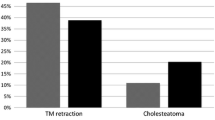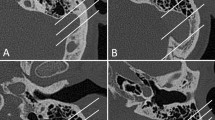Abstract
Purpose
To evaluate the clinical and radiological features and the risk of middle ear disease in the contralateral ears of unilateral cholesteatoma with clinical and radiological assessment.
Methods
Fifty-two patients with unilateral cholesteatoma and 30 control subjects underwent otoscopic and audiologic examination. Temporal bone computed tomography was performed to evaluate the pneumatization of the temporal bones, the status of anterior epitympanic space and eustachian tube. Then, the parameters of the temporal bone pneumatization were calculated.
Results
28 % of the contralateral ears in the cholesteatoma patients showed abnormal tympanic membrane findings. In the audiologic examination, 10 % of the contralateral ears showed moderate hearing loss and 3 % showed severe hearing loss. Aeration areas were 1.81 ± 1.01, 2.50 ± 1.31 and 4.49 ± 1.45 cm2, aeration ratios were 24, 28 and 42 %, in cholesteatoma, contralateral and control ears, respectively. Development of the anterior epitympanic space and eustachian tube patency was reduced in contralateral ears relative to control ears.
Conclusions
The degree of temporal bone pneumatization, eustachian tube function, and development of the anterior epitympanic space are significantly decreased in the contralateral ears of unilateral cholesteatoma patients, and there is an increased risk of middle ear diseases. Continuous monitoring of the contralateral ear is crucial for early detection and optimal treatment of middle ear disease.




Similar content being viewed by others
References
Austin DF (1977) On the function of the mastoid. Otolaryngol Clin North Am 10:541–547
Deguine C (1990) The contralateralear in cholesteatoma. Rev Laryngol Otol Rhinol (Bord) 11(5):463–468
Khalil HM, Saleh MA, Sakr A (2004) A clinico-radiological study of the contralateral ear in acquired unilateral cholesteatoma. Rev Laryngol Otol Rhinol 125(1):17–22
Kim CS, Jung HW, Yoo KY (1993) Prevalence and risk factors of chronic otitis media in Korea: results of nation-wide survey. Acta Otolaryngol (Stockh) 113:369–375
Koç A, Ekinci G, Bilgili AM, Akpinar IN, Yakut H, Han T (2003) Evaluation of the mastoid air cell system by high resolution computed tomography: three-dimensional multiplanar volume rendering technique. J Laryngol Otol 117(8):595–598
Min HJ, Kim SG, Jung JH, Jeong JH, Lee SH, Park CW (2011) Epitympanic development and mastoid pneumatization in chronic otitis media with and without cholesteatoma. Korean J Audol 15:25–31
Olszewska E, Wanger M, Bernal-Sprekelsen M et al (2004) Etiopathogenesis of cholesteatoma. Eur Arch Otorhinolaryngol 261:6–24
Paparella MM, Schachern PA, Yoon TH et al (1990) Otopathologic correlates of the continuum of otitis media. Ann Otol Rhinol Laryngol 99:17–22
Sade J, Avraham S, Brown M (2008) Atelectasis, retraction pocket and cholesteatoma. Acta Otolaryngol 72:1419–1423
Sade J (1992) The correlation of middle ear aeration with mastoid pneumatization. The mastoid as a pressure buffer. Eur Arch Otorhinolaryngol 249:301–304
Saggese D, Pirodda A, Palma S, Nola G, Rinaldi Ceroni A (1997) The contralateral ear in acquired cholesteatoma in children and adults. Acta Otorhinolaryngol Ital 17(6):414–418
Selaimen da Costa S, Rosito LP, Dornelles C, Sperling N (2008) The contralateral ear in chronic otitis media: a series of 500 patient. Arch Otolaryngol Head Neck Surg 134(3):290–293
Sirikci A, Bayazit YA, Bayram M, Kanlikama M (2001) Significance of the auditory tube angle and mastoid size in chronic ear disease. Surg Radiol Anat 23(3):91–95
Takahashi H, Honjo I, Naito Y (1997) Gas exchange function through the mastoid mucosa in ears after surgery. Laryngoscope 107:1117–1121
Tos M, Stangerup SE (1985) The causes of asymmetry of the mastoid air cell system. Acta Otolaryngol 99:564–570
Tsuji T, Yamaguchi N, Aoki K, Mitani Y, Moriyama H (2000) Mastoid pneumatization of the patulous Eustachian tube. Ann Otol Rhinol Laryngol 109(11):1028–1032
Conflict of interest
The authors report no conflicts of interest. They alone are responsible for the content and writing of the paper.
Author information
Authors and Affiliations
Corresponding author
Rights and permissions
About this article
Cite this article
Chung, J.H., Lee, S.H., Min, H.J. et al. The clinical and radiological status of contralateral ears in unilateral cholesteatoma patients. Surg Radiol Anat 36, 439–445 (2014). https://doi.org/10.1007/s00276-013-1204-3
Received:
Accepted:
Published:
Issue Date:
DOI: https://doi.org/10.1007/s00276-013-1204-3




